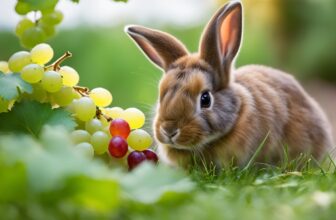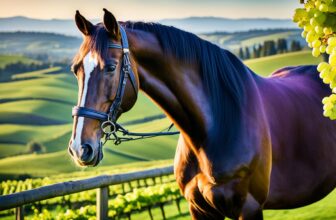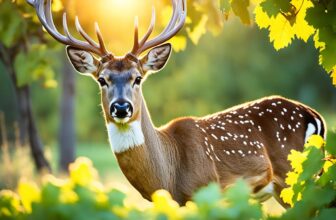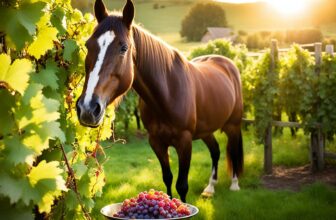Can Deer Eat Grapes? A Wildlife Diet Guide
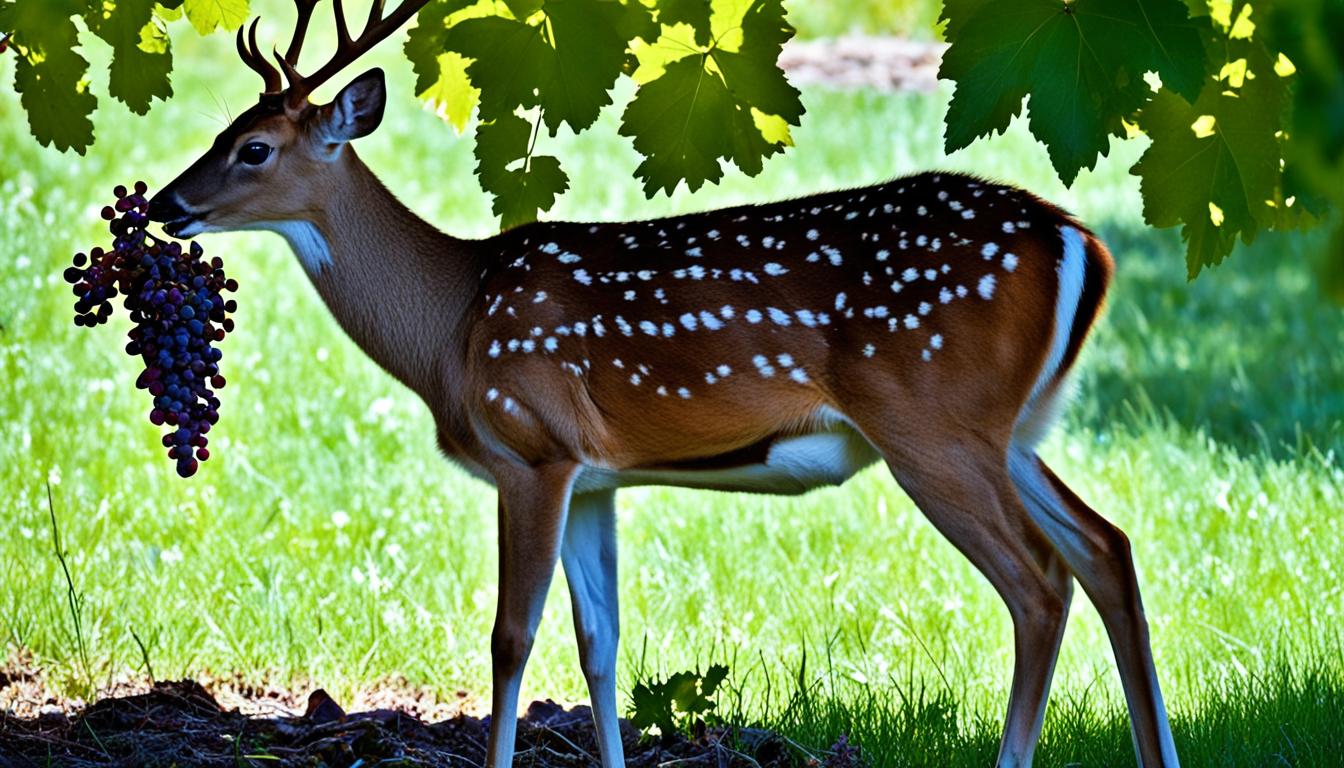
Have you ever wondered whether deer can safely consume grapes? As gardeners and vineyard owners grapple with the challenges of deer foraging, understanding the dietary preferences and nutritional needs of these magnificent creatures is crucial. In this comprehensive guide, we’ll explore the complex world of deer diets, uncover the truth about grape toxicity, and discover effective strategies for managing deer populations in a way that benefits both wildlife and human interests.
Key Takeaways
- Deer have a complex digestive system that requires frequent replenishment of their rumen contents.
- Whitetails prefer forbs, browse plants, and high-energy foods like acorns and fruits, but grasses are rarely a preferred food item.
- Deer shift their diet seasonally, adapting to the availability of different food sources.
- Regional variations in preferred deer foods exist, with certain plants like beaked hazel and greenbrier being local favorites.
- Understanding deer foraging habits and managing deer-friendly habitats can help minimize conflicts with gardens and vineyards.
What Deer Eat and Why It Matters
Understanding a Deer’s Digestive System
Deer are classified as “concentrate selectors,” meaning they have a specialized digestive system that allows them to selectively forage on specific plant parts, unlike cows which are “roughage eaters.” This unique adaptation enables deer to thrive on a diverse diet that includes browse (leaves and twigs), forbs (weeds), grasses, nuts and fruits, and even mushrooms.
The availability and nutritional value of these food sources can vary significantly by season and region. For instance, grasses comprise less than 10% of the overall diet of white-tailed deer, as they prefer to consume more nutrient-dense forbs that can contain protein levels ranging from 15-35%. Warm season perennial grasses, on the other hand, do not meet the deer’s essential nutrient requirements.
Deer often feed along field edges due to the greater diversity of food sources available in these transition zones. Browse plants, which are deeply rooted and persist through the summer, are the mainstay of a deer’s diet, while forbs are most numerous during rainy seasons like spring and fall, providing deer with high protein levels.
| Deer’s Preferred Food Sources | Nutritional Value |
|---|---|
| Browse plants (leaves and twigs) | Stable food source year-round |
| Forbs (weeds) | High protein levels during rainy seasons |
| Grasses | Less than 10% of overall diet, not preferred |
| Mast (acorns, pecans, persimmons) | Important energy-rich food source |
| Mushrooms | Provide phosphorus and protein |
Understanding the deer’s specialized digestive system and their preference for a diverse diet is crucial in managing their habitat and ensuring optimal nutrition. By catering to their unique feeding habits, wildlife managers can create environments that support healthy deer populations.
Seasonal Food Preferences for Deer
Deer’s dietary preferences and nutritional requirements vary throughout the year. In early spring, deer focus on highly digestible and nutrient-rich forbs to regain weight and support antler growth. As summer approaches, they shift to browsing on woody plants and consuming early fruits like grapes and berries.
In the fall, deer seek out carbohydrate-rich foods like acorns, chestnuts, and apples to build fat reserves for the winter. Mushrooms are also an important source of phosphorus and protein during antler growth and fawn rearing.
White Cedar is a preferred deer food, with browsing deer consuming practically all cedar within reach in many areas. In contrast, Spruce and Red Pine are classified as “starvation” deer foods, indicating that deer will eat them only as a last resort. Yellow Birch, on the other hand, is highlighted as a preferred food due to its wintergreen taste in twigs.
- Spring: Nutrient-rich forbs, young grasses
- Summer: Woody plants, early fruits like grapes and berries
- Fall: Carbohydrate-rich foods like acorns, chestnuts, and apples
- Winter: Woody browse, mushrooms for protein and phosphorus
Deer are adaptable and can consume more than 400 documented plant species. However, grass is not a staple food for them; they prefer forbs, young grasses, bushes, acorns, and mushrooms among other options. Knowing deer’s food preferences and seasonal eating patterns can help hunters locate and understand deer movements for a successful hunt.
Can Deer Eat Grapes?
Grapes are generally considered safe for deer to consume, and they are often a preferred food source, especially during the summer and fall months. Deer are attracted to the high sugar and carbohydrate content of grapes, which provide them with a valuable energy source.
However, it’s important to note that the skins and seeds of grapes can be difficult for deer to digest, and in large quantities, they may cause digestive issues. Moderation is key when it comes to deer consuming grapes, and they should be just one part of a varied, balanced diet.
According to research, deer enjoy both raw grapes and raisins, with a particular preference for raisins. Grapes are a favorite of deer, and they can cause significant damage to vineyards by feeding on the leaves and fruits. While grapes and raisins are toxic to dogs and can cause kidney failure, they are generally safe for deer in moderation.
Interestingly, deer have also been observed to eat other dried fruits and berries, such as cranberries, currants, and apricots. These types of dehydrated fruits and berries are often included in deer feed as a source of nutrients and energy.
| Nutrient Comparison | Grapes | Raisins |
|---|---|---|
| Antioxidant Capacity | Lower | Nearly 3 times higher |
| Water-soluble Vitamins | Higher | Lower |
| Minerals | Copper, iron, calcium, magnesium, phosphorus, potassium, selenium, and zinc | Copper, iron, calcium, magnesium, phosphorus, potassium, selenium, and zinc |
While deer may enjoy grapes, it’s important to note that they should be consumed in moderation as part of a balanced diet. Growers and homeowners should be aware of the potential for deer damage to grapevines and take appropriate measures to deter them, such as using electric fences or repellents.

“Deer love all things breakfast cereal: oatmeal, nuts, raisins, or other dehydrated fruits and berries, with a preference for raisins.”
Regional Variations in Deer Diet
Deer’s dietary preferences can vary significantly by geographic region, with certain browse plants being more or less preferred depending on the local environment. Wildlife biologists classify browse plants into three categories: 1st, 2nd, and 3rd choice. Understanding the 1st choice browse plants in a specific region can help identify prime deer feeding areas.
Preferred Browse Plants by Region
For example, in Eastern Canada, deer prefer beaked hazel, white cedar, and ground hemlock, while in the Southeastern United States, their 1st choice preferred deer browse plants include greenbrier, Japanese honeysuckle, and Alabama supplejack.
| Region | 1st Choice Deer Browse | 2nd Choice Deer Browse | 3rd Choice Deer Browse |
|---|---|---|---|
| Eastern Canada | Beaked hazel, White cedar, Ground hemlock | Red maple, Serviceberry, Striped maple | Birch, Willow, Balsam fir |
| Southeastern U.S. | Greenbrier, Japanese honeysuckle, Alabama supplejack | Muscadine grape, Pokeweed, Blackberry | Kudzu, Sumac, Dogwood |
Over 600 plant species have been identified in the regional deer diet of white-tailed deer in Missouri, showcasing the diverse preferred deer browse plants across different regions.
“Deer diets vary based on sex (male or female), age (fawn, yearling, or adult), physiological state, and weather conditions.”
Factors such as sex, age, and seasonal changes can also influence a deer’s 1st choice deer browse, 2nd choice deer browse, and 3rd choice deer browse preferences. Careful deer habitat management is crucial to ensure optimal regional deer diet and nutrition for thriving deer populations.
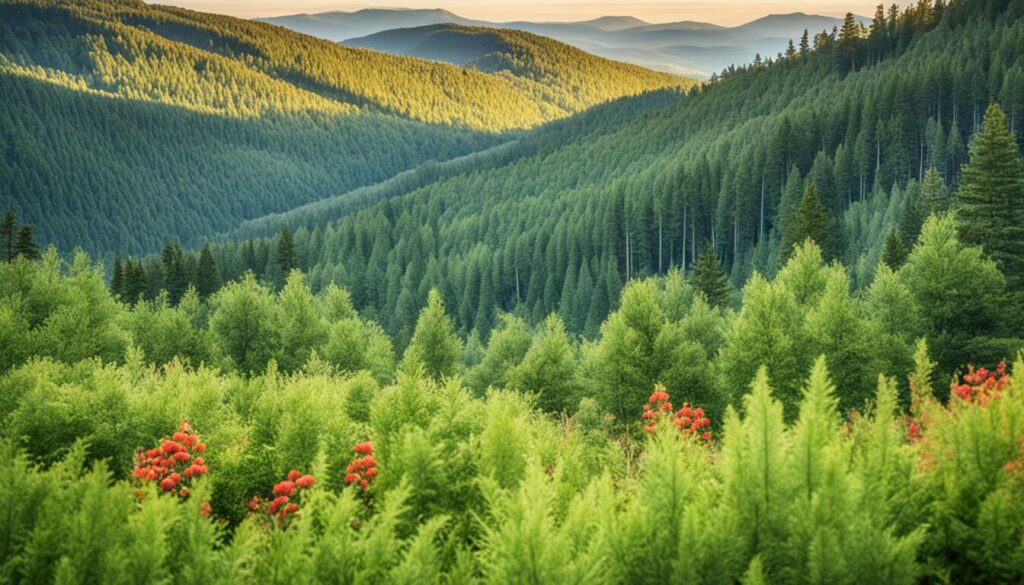
Managing Deer Habitat for Optimal Nutrition
Maintaining a healthy and thriving deer population requires a careful approach to habitat management. At the heart of this strategy is providing a diverse array of high-quality, nutritious food sources that cater to the deer’s seasonal dietary preferences and needs. By understanding the intricate details of a deer’s digestive system and foraging habits, landowners and wildlife managers can create an optimal habitat that supports the deer’s overall well-being.
Crucial to this process is incorporating a variety of browse plants, forbs, and mast-producing trees and shrubs into the landscape. Browse plants, which make up 80% of a deer’s winter diet, include favorites like sumac, yellow birch, white pine, and oak buds. Forbs, on the other hand, are high in protein and essential for deer growth and reproduction. Mast-producing plants, such as acorns and berries, provide valuable sources of nutrition during the late summer and early fall.
In addition to diversifying the food sources, managing deer populations through hunting or other means can help protect valuable crops, gardens, and vineyards from deer damage. Deer-resistant plants can also be strategically incorporated to deter browsing and minimize the impact on sensitive areas. By striking the right balance between providing ample nutrition and managing deer numbers, landowners can create a sustainable habitat that supports a thriving deer population while safeguarding their own interests.
Ultimately, the key to effective deer habitat management lies in understanding the intricate relationship between the deer’s dietary needs and the available food sources. By carefully curating the landscape, landowners and managers can ensure that deer have access to the nutrients they require, promoting a healthy and stable population that coexists harmoniously with the surrounding environment.
Optimizing Deer Habitat for Optimal Nutrition
- Incorporate a diverse array of browse plants, forbs, and mast-producing trees and shrubs to cater to the deer’s seasonal dietary preferences.
- Manage deer populations through hunting or other means to protect valuable crops, gardens, and vineyards from damage.
- Strategically plant deer-resistant plants to deter browsing and minimize the impact on sensitive areas.
- Provide water sources such as small ponds or pools near shelter areas to attract deer and various wildlife species.
- Maintain young forest regeneration with stands of young aspen, pine, and spruce to serve as prime cover for deer bedding.
“Deer management focuses on food quantity and quality, emphasizing habitat management and supplemental feeding when needed.”
By understanding the intricate details of a deer’s dietary needs and foraging habits, landowners and wildlife managers can create an optimal habitat that supports a thriving deer population while also protecting valuable assets. Through a thoughtful and balanced approach to deer habitat management, a harmonious coexistence between deer and their human counterparts can be achieved.
Conclusion
In conclusion, deer can safely consume grapes in moderation as part of a varied, balanced diet. However, understanding the broader dietary preferences and nutritional requirements of white-tailed deer is crucial for effectively managing deer populations and minimizing their impact on agricultural and residential areas. By creating a diverse, deer-friendly habitat and implementing targeted management strategies, landowners and wildlife managers can support healthy deer populations while protecting valuable resources such as vineyards, orchards, and ornamental gardens.
The impact of deer on grapes, as well as other plants, can vary significantly based on regional factors and deer population densities. Strategies like exclusion fencing, noise-making devices, and carefully timed hunting may be effective in controlling deer damage, but their success often depends on the specific local conditions. Furthermore, cost-sharing programs offered by state agencies can provide valuable resources for implementing these deer management techniques.
Ultimately, by fostering a deeper understanding of can deer eat grapes, deer diet, and deer habitat management, gardeners, farmers, and wildlife professionals can develop comprehensive solutions to address the complex challenges posed by deer population control and deer-resistant plants. Through a balanced approach that considers the needs of both deer and human interests, we can create thriving, sustainable environments that benefit ecosystems, agriculture, and our communities.



